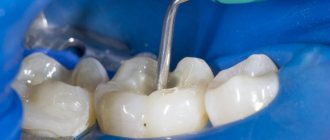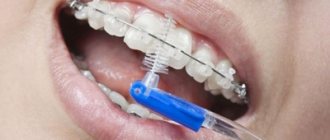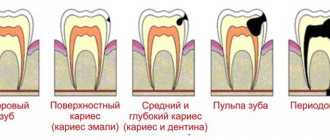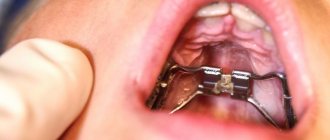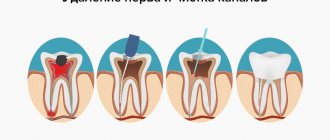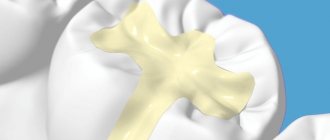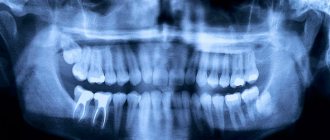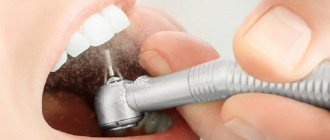Toothache after pulpitis treatment
After visiting the dentist, some patients repeatedly seek medical help because their tooth hurts after pulpitis treatment.
The symptom cannot be called pleasant - the pain can be quite insignificant and periodically subside, or it can develop progressively, gradually leading to round-the-clock suffering for a person. Signs of discomfort may also appear when biting, while chewing solid food, or when hot or cold drinks come into contact with a recently treated tooth. Sometimes mild pain is considered normal, especially after treatment of an advanced stage of the disease. However, if the discomfort does not go away and even increases for 2-3 days in a row, you cannot delay a second visit to the dentist - this is fraught with the development of dangerous complications.
METHODS OF TREATMENT OF PULPTIS
This is a serious problem, but it can be removed in two or three visits to the dentist. Typically, pulpitis is treated according to the following scheme:
- The dental canals are completely cleared of inflamed tissue and the nerve is removed. Medicine is placed into the root canals to stop the inflammation, and a temporary filling is placed on top. During the second visit, the temporary filling is replaced with a permanent one after the doctor determines that there is no more inflammation.
At Clarimed from 7800 rubles
.
- If a tooth is completely destroyed due to a large carious cavity, which caused pulpitis, then it needs to be restored. A stump inlay is first installed: it will replace the pin and you can put a crown on it or build up the top of the tooth using composite materials.
In “Klarimed” from 5933 rubles.
- To restore the cutting or chewing properties of a tooth and its aesthetics, a crown can be installed. This will be needed if the top of the tooth is severely damaged. Without a crown, decay will continue, leading to tooth extraction.
In “Klarimed” from 7875 rubles.
The specialists at the Clarimed clinic have extensive experience in the treatment of pulpitis and dental restoration, so we can offer you the correct treatment plan for any stage of the disease.
EXPERT OPINION: IS IT POSSIBLE TO REMOVAL PULPITIS WITH FOLK REMEDIES
Experts recommend abandoning folk remedies for treating pulpitis and contacting a dentist as soon as possible.
We are approached by patients who have suffered burns to their mucous membranes due to decoctions, garlic, and alcohol. Their situation worsens, because in addition to the main problem, they will have to spend time and money on treating these injuries.
Acupuncture is also ineffective, and in some cases dangerous, because it reduces pain while the inflammation continues, and the patient thinks that he is recovering.
What is pulpitis and indications for its treatment
Each human tooth consists of two parts - the crown, which rises above the gum, and the root, located deep in the bone tissue. The inner molar often consists of a cavity densely stuffed with nerve endings and thin blood vessels, it is called the pulp. If a patient ignores the symptoms of caries, toothache, or receives a mechanical injury for a long time, an infection gets inside the tooth, causing an acute inflammatory process.
If the internal canal is not cleaned in time, the infected tissue will penetrate deep into the bone and cause the formation of a granuloma or cyst at the root apex. With such an advanced complication, sometimes it is not even possible to save the tooth, and the only solution is its removal.
Unpleasant sensations may increase after a severe cold, decreased immunity, stress, or hypothermia. Cleaning the canals must be carried out before the infection spreads to neighboring tissues, since untimely removal of the nerve or necrotic tissue from the tooth can provoke its complete loss - the molar will have to be removed.
Indications for cleaning tooth canals:
- acute and chronic pulpitis;
- acute and chronic periodontitis;
- mechanical damage to the tooth, during which its cavity was opened and the nerve was exposed.
Treating a tooth affected by pulpitis means not only treating the canals, cleaning and drying them, but also filling them with a special filling material. To do this, dentists use pastes, often with anti-inflammatory substances; filling the canals eliminates the possibility of bacterial flora getting inside the tooth.
The cause of toothache with pulpitis, what is its character
The cause of pulpitis is an infection that has penetrated through the tooth enamel and affects dentin . Dentin is the last barrier to infection on the way to the pulp. Passing through it, pathogenic microorganisms affect the nerve endings and blood vessels located in the pulp chamber and root canals. And this is precisely what causes the severe pain that occurs with pulpitis.
Attention should be paid to the fact that pain tends to intensify at night . This is due to the physiological position of the body during sleep.
In a horizontal position, blood flows more to the head, and, in particular, to the jaw, which increases blood flow to the inflamed area and creates excess pressure on it. This leads to the fact that the central nervous system signals sent by the nerve bundle are amplified.
Among other things, under the influence of human biorhythm in the evening, blood pressure can increase even in healthy people. This can also cause toothache if a person has not yet gone to bed.
In acute
As mentioned earlier, pain with pulpitis varies depending on the type of inflammation.
The clinical picture of acute pulpitis is as follows:
- The nature of the pain is cutting, tearing, shooting.
- The pain is very strong, paroxysmal . It intensifies at night, but can also appear during the day.
- Painful sensations can intensify with mechanical pressure on the tooth, exposure to heat, cold, spicy or sour foods.
- The pain persists for 2-3 weeks , gradually subsiding.
- In acute inflammation, the tooth cavity is most often covered with softened dentin tissue.
Reference. Unlike caries, when there is also a reaction of the teeth to food or temperature, with pulpitis the pain does not go away immediately after removing the irritant.
Acute pulpitis has 2 stages:
Focal
The initial stage of inflammation lasts up to two days . During this period, the causative tooth is easy to detect, since irradiation is not yet observed and only part of the neurovascular bundle is involved in the inflammatory process.
At this time, pain occurs in spontaneous attacks, which can be provoked by various types of irritants. The duration of the pain is about half an hour , and with further development of the disease it can increase to two hours and intensify at night.
Diffuse
The next stage of the disease, in which inflammation covers the entire pulp. During this period, the pain is diffuse, radiating to different parts of the jaw , temporal and occipital parts of the head, and cheekbones. If there is inflammation in the teeth of the lower jaw, the pain radiates to the ear and back of the head, in the upper jaw - to the superciliary area and temple.
During this period, it is impossible to indicate the causative tooth, as with focal pulpitis. Attacks of pain become longer and can last for hours.
The pauses between them are only 30-40 minutes .
Acute diffuse pulpitis lasts no more than two weeks , after which it can become chronic.
How long can it last for chronic?
Chronic pulpitis also has several stages. During the development of each of them, the pain is not as severe as in the acute form of the disease. In some cases, when a cavity has formed inside the tooth and it continues to secretly deteriorate from the inside, painful symptoms may be completely absent.
The danger is precisely the lack of severity of the pain syndrome. It can last, without disturbing the patient too much, for up to several years . Toothache is significantly dulled, you can get used to it, although chewing is difficult, and with external influences the pain intensifies. Bleeding may occur at times.
Causes of pain after treatment
Why does a tooth hurt after pulpitis removal? In some situations, unpleasant sensations are natural and persist for no longer than 1–2 days, without being accompanied by an increase in temperature or a general deterioration in well-being. In case of gross mistakes made by the dentist during the treatment procedure, various complications arise.
Statistics of all cases of repeated visits by patients with acute toothache after treatment indicate that in at least 60% of cases, unpleasant consequences are provoked by the illiterate work of the dentist, who is not always in a hurry to redo it and eliminate mistakes made. In such a situation, it is necessary to take an x-ray, which can be used to assess the quality of the service provided. It is necessary to consider the main reasons why acute attacks of pain may develop after treatment of pulpitis.
Injury to tissue at the root apex
Often the cause of minor pain in the teeth after treatment lies in the technical nuances of its implementation, for example:
- during pulp removal, a bundle of nerves and capillaries was torn off at the level of the apex of the tooth root;
- during instrumentation, the tissues of the root apex were injured if the tips of the instruments extended beyond the canals;
- antiseptic treatment of the root canals was carried out using strong solutions - a small amount of it got outside the root canal, causing irritation. At the same time, the patient notes that not only the tooth aches, but also the gums hurt when pressed - this is a sign of irritation of the mucous tissue.
Poorly filled root canals
The fact that the treatment of pulpitis was carried out poorly is indicated by pain in the gum area and the affected tooth, as well as swelling of the mucous tissue. It’s good that if the pain is intense, it will force the patient to return to the dentist to find out and eliminate the cause. If the discomfort is minimal, a person can tolerate it for a long time without visiting a doctor. In such a situation, symptoms of poor-quality treatment of tooth canals can only be detected with the help of an X-ray examination.
Pulpitis is an inflammatory process localized inside the pulp tissue, which developed due to the entry of pathogenic microbial flora into the tooth cavity. When a doctor expands the dental canals, cleans them with medication and removes the pulp, a small number of microbes still remain in the tissue. Therefore, if the canal was filled with filling material not completely or not to the top, and there were voids inside, a favorable environment for the proliferation of microbial flora was created in them.
The infection will enter the adjacent tissues around the diseased tooth, through the hole in the root apex, which will subsequently lead to the formation of a periodontal abscess (purulent sac) in this area. What should you do if you experience severe pain in your tooth and gums due to poor quality filling? In order to save the tooth (the inflammatory process of the root apex often leads to periodontitis with further loss of the molar), it is necessary to re-treat it as soon as possible.
To do this, the tooth canal is reopened and filled again. If the material lies tightly throughout its entire length, and pores remain only at the top, doctors resort to the procedure of resection of the root tip. In such a situation, it is possible to do without opening the channels.
Extension of material beyond the root apex
When, during the treatment of dental canals and subsequent filling, the material accidentally extends beyond the apex, this phenomenon can also be accompanied by pain. The situation for each patient is decided individually, depending on how much material was removed. If it is minor, then the doctor may advise you to endure the pain for a while, usually this takes 1–2 months.
If the pain is not intense, and the patient can fully eat, work and sleep, then after the specified period, the discomfort goes away on its own, without specific treatment. When a large amount of material is removed beyond the apex, and the patient’s pain is pronounced, treatment cannot be avoided. It is necessary to resect the root tip by making a hole in the bone. Through it, excess material is removed, the operation lasts no longer than 40 minutes and is not classified as complex.
Breaking off a dental instrument
Sometimes, due to the fault of a doctor who violates the technique of using dental instruments, it breaks off right in the cavity of the dental canal. This usually happens during its processing or already at the filling stage. Sometimes it is possible to remove the fragment immediately, especially if it is located in the first third of the canal, but it is not always possible to remove a piece of metal stuck in the tissues of the root apex.
The fragment of the instrument remaining in the canal cavity will not allow the filling material to be fully applied; pores will remain inside where pathogenic microbes will begin to multiply. It is this process that causes intense pain after treatment. Therefore, if such a case is confirmed by an x-ray, it is necessary to reopen the canal and be sure to remove a piece of metal, and then re-fill it.
Perforation of the tooth root
If instrumentation is carried out simultaneously with screwing the pins into the canals, this can lead to perforation (perforation) of the root apex. This situation in dental practice is considered the most difficult, since it is usually very difficult to eliminate its consequences. Root perforation can occur due to the fault of the doctor, but sometimes it can be predictable when the dentist has to treat very curved and narrow canals.
Read also: How to relieve tooth pain
If the canals are difficult to pass, then it is difficult for even a qualified doctor to do quality work, but with an average diameter, only negligence can lead to perforation. To correct the perforation, you will need quite expensive materials, which the clinic itself must pay for (if it is proven that the incident occurred due to poor quality work by the doctor).
Allergic reaction
No one has canceled the allergic reaction to the material with which the tooth canals were filled. Modern dentistry now offers high-quality materials that are characterized by a long service life and good survival rate, however, with a pronounced tendency to allergies, an unexpected reaction may still develop in the patient.
An allergy to fillings is manifested by the following symptoms:
- swelling of the lips and cheeks on the affected side;
- pain in tooth tissues;
- swelling of the gums;
- lack of effect from taking painkillers.
How long does a tooth hurt during an allergic reaction? Symptoms may persist for weeks until the patient visits the dentist again and the doctor is unable to resolve the problem. The pain can increase in intensity every day, while the swelling of the gum tissue, lips and cheeks does not subside.
If, in the process of identifying the causes of pain and swelling, an x-ray was taken, which clearly shows that the work was done efficiently, this should prompt the dentist to think about the patient’s intolerance to the material chosen for filling. What to do in such a situation? Simply replace the filling with another one, consisting of a material different from the first one, then the pain will go away on its own, and the swelling of the tissue will be relieved by several doses of antihistamine tablets.
Causes of tooth pain
The statistics are not always reassuring - in 65% of cases the dentist makes mistakes. This occurs due to the complex course of the disease, physiological characteristics, and other reasons, including the low competence of the specialist. Therefore, it is imperative to monitor your condition.
It is strongly recommended to conduct a follow-up study after treatment. With its help, it is possible to determine how well, correctly and effectively the procedures were completed. If everything is in order, the pain will subside.
Tissues are injured
Inflammation of the pulp - the nerve bundle is located in the gum area. Soft tissues may be damaged during the procedure. The damage can be minor and brings a lot of trouble.
- the vascular bundle is torn off during manipulation, so the tissue structure is damaged in any case,
- root canals were processed with instruments that disrupted the tissue structure - as a result, the gums were damaged,
- rinsing with antiseptics led to exposure to the area beyond the border of the root canal (severe irritation may occur if powerful antiseptics come into contact with it).
Recovery from injuries usually takes 3 days.
Poor quality canal filling
Symptoms of poor quality treatment:
- swelling of the gums,
- It's a dull pain,
- bad feeling,
- lack of proper effect from painkillers.
Poor quality filling can be determined by external signs, when the filling seems to stick out upward or is installed in such a way that a person experiences discomfort. However, in most cases, errors in filling are not externally visible; they are determined only using an x-ray.
Signs of problems with the filling material, which can be seen on the X-ray image:
- the filling does not reach the limit of the canal,
- the filling is located outside the root,
- a fragment of foreign origin is visible,
- root perforation (its solid structure is damaged).
Each of these problems needs to be addressed as soon as possible.
Possible complications
The consequences of poor treatment of pulpitis can be as follows:
- development of periodontitis;
- formation of abscesses and cysts in the root apex area;
- osteomyelitis;
- phlegmon;
- prolonged pain leading to neuralgia;
- tooth extraction as a result of untimely redoing of poor quality work.
To avoid such consequences, it is necessary to seek medical help in a timely manner, immediately when pain develops. If signs of pulp inflammation are ignored by the patient, the infection can spread to the surrounding tissue and then into the general bloodstream, causing sepsis. Therefore, it is necessary to start treatment immediately, so as not to undergo long-term restorative therapy later, possibly in a hospital setting (for example, when phlegmon forms).
Complications after dental treatment
As a result of errors in the treatment of pulpitis, the following types of complications can arise:
- Periodontitis. It appears due to incomplete filling with filling material, and always and in all cases. The main danger is that pain is not always present with such a problem.
- Flux. The inflammatory process is not uncommon with errors in therapy. Inflammation occurs when a pathogenic environment develops in tissues, resulting in tissue damage.
- Cyst. Depending on the nature of the error, the gradual development of the pathology leads to the formation of a cyst, which will subsequently have to be removed.
- Removal of a tooth. If the root is fractured, the tooth will have to be removed. In other cases, if the errors are serious, such a danger may also arise. The formation of a cyst will require similar manipulations, only after some time, when health difficulties become obvious due to constant pain.
How to help yourself
If pain in the gums persists, but for some reason the patient is unable to visit the dental office, you can try to get rid of the discomfort yourself. How long the pain syndrome will persist and whether it will be possible to get rid of it at home depends on the cause that provoked it.
First aid rules:
- It is strictly forbidden to apply warm compresses to the affected area. In warm conditions, pathogenic microorganisms that may have caused pain will begin to actively multiply, which will only accelerate the development of the inflammatory process. Next, pus begins to accumulate in the tissues, which can enter the general bloodstream, causing sepsis (blood poisoning).
- Pulpitis is provoked by the carious process in the oral cavity and the microbial environment living there. Therefore, to avoid inflammation, it is necessary to visit the dentist regularly. You can independently reduce the level of inflammation by rinsing your mouth with a Chlorhexidine solution for several days in a row. If pain occurs after filling, you need to reopen the canals and re-treat.
- Minor trauma to the gum tissue can also provoke an inflammatory process; you can disinfect the mucous membrane and prevent suppuration by rinsing your mouth with a solution of baking soda, chamomile decoction or an alcohol tincture prepared with horseradish extract.
If the listed measures do not help relieve pain and inflammation, you should not delay your visit to the doctor in order to avoid dangerous consequences. Since in the process of treating pulpitis the doctor can carry out instrumentation, cleaning, pulp removal and other manipulations, the development of slight pain within 1-2 days is a normal reaction of the body.
If 4-5 days have passed after visiting the doctor, and the patient feels a general deterioration in his condition, his temperature has risen, and an ulcer or growth has formed in the cavity, these symptoms cannot be ignored. No matter how highly qualified the dentist may be, the patient himself must first of all help himself by carefully monitoring the condition of his oral cavity and visiting the doctor regularly.
How to relieve tooth pain after treatment
How bad can a tooth hurt after pulpitis treatment and for how long? The maximum recovery period is three days. The minimum is one day. Depending on the individual characteristics of the body, this period varies upward and can be a week if the tissues have been severely damaged, but the inflammatory process gradually decreases.
One of the simplest methods of dealing with pain is using water with soda and salt for rinsing, but it can be classified as a folk, home method.
Oak bark and chamomile are used to prepare a decoction. They rinse the mouth with it - this relieves inflammation, but it is difficult to assert the effectiveness of the method if the cause of intense pain is concentrated in serious medical errors.
Ketanov is an effective pain reliever whose effect lasts for 8-12 hours. The period may vary depending on the individual characteristics of the organism. Supplied in the form of tablets for oral use and injection. Injections are more often used in the postoperative period. The tablet form is suitable for home use.
Diclofenac is another inexpensive pain reliever. It is considered quite effective and can be taken for a long time (up to 7 days in a row). It has less effect than Ketanov, but the effect after administration is felt almost immediately. You can suck it so that the components of the product get onto the gum area and act quickly; the tablets taste bitter.
Many anesthetics are made from Ibuprofen. The names are different, the composition is similar.
Nurofen is available in several forms. A syrup is provided for children, which is easy to take, it is quite tasty, and is even offered in several flavors. Nurofen helps normalize temperature, relieves pain, improves condition, and helps overcome the rehabilitation period in the first days.
It is recommended to buy those anesthetics that you have already used. This will help avoid the occurrence of an allergic reaction. Usually the doctor makes an appointment after the procedure, but in practice this does not always happen.
Some painkillers not only relieve discomfort in the tooth, but also reduce inflammation, these are Diclofenac and Aceclofenac. These products are not widely used in dentistry, but are quite effective.
Nimesulide (Nise), Indomethacin is often used in dental practice. There is also an anti-inflammatory effect, pain relief, and improvement in the patient’s condition, but the price for this group of drugs is higher.
Paracetamol and Analgin are cheap painkillers. They are practically not prescribed, and many are even feared due to some scientific findings that indicate a toxic effect on the body with frequent or excessive use. If you follow the rules specified in the instructions, there can be no danger provided that there is no allergic reaction to the components of the drugs.
Causes of pain after pulpitis treatment
It is known that in some cases pain is a normal reaction of the body to intervention - then the unpleasant sensations have an unexpressed, aching character and appear on the first day after the manipulations.
If mistakes are made during the treatment and filling of root canals, pain may occur several days, weeks or months after treatment; its nature can be either acute or aching. The reasons why a treated tooth may hurt are conditionally divided into groups, depending on at what stage the mistakes were made.
Violation of the tooth processing process
When treating pulpitis, it is necessary to remove the affected neurovascular bundle (pulp) and use special instruments to treat the canal walls along its entire length. The appearance of acute pain indicates that the dentist missed the root canal and did not remove the entire pulp.
Another reason for aching pain in the first few days after the procedure is the removal of a small volume of antiseptic solution beyond the apical foramen. When the antiseptic gets into the top of the canal, pain appears, which can persist for 2-3 days.
Perforation of the root wall is a serious complication of canal treatment, in which the dentist creates a hole in the wall with an instrument. This error requires mandatory correction; special expensive material is used to close the perforation.
Often, pain in the treated tooth occurs a long time after all the interventions. The reason for this may be the presence of a fragment of an instrument in the root canal, which is often a source of infection or irritation of periodontal tissue. Unfortunately, the instruments are quite fragile and can break, this especially often happens when treating teeth with curved roots.
In some cases, the splinter can be removed if it is in the upper third of the root. If the fracture occurs closer to the root apex, it is often not possible to pull out the instrument - in this case, the canal is treated bypassing the fragment or the patient is sent for surgical treatment.
Errors during the filling process
Aching pain in the teeth, which occurs some time after treatment and intensifies with chewing, indicates the development of inflammation. In this case, the gums near the causative tooth often hurt; sometimes you can notice a small formation on it - a fistula, from which fluid is separated.
There are several mistakes when filling a canal that can cause tooth pain:
- The canal is not filled to its full length. Even with full treatment, a certain amount of microflora remains, and if the canal is not completely sealed, microorganisms multiply in the free areas and the infection spreads beyond the apex, resulting in the development of periodontitis.
- Removal of material beyond the apex of the tooth root. To fill root canals in modern dentistry, gutta-percha points are used. Ideally, the canal is filled to the apex without going beyond it. If the technology is violated, gutta-percha leaves the apex, irritating the tissues around the tooth - in this case, the patient will feel aching pain that intensifies with chewing. Over time, this will lead to the formation of a focus of inflammation.
Read also: Do teeth rot under crowns?
Why does a tooth hurt after removing a nerve from a tooth?
Pain after treatment of pulpitis can be minor or acute. The appearance of pain can be associated with injury (to a lesser extent), but most often with the development of inflammation.
Trauma to tissues in the area of the apex of the tooth root –
Since the treatment involves the removal of the inflamed pulp (neurovascular bundle) and filling the root canals, it is quite reasonable that minor pain may occur due to the following:
- During the process of pulp removal, the neurovascular bundle is detached at the level of the apex of the tooth roots,
- Instrumental treatment of the root canals was performed. During this process, the tips of the instruments, extending slightly from the root canal beyond the root apex, can injure the tissue in the area of the root apex.
- The root canals were treated with medication by rinsing them with antiseptics. Antiseptic agents can enter in small quantities outside the root canals - into the tissue at the root apex. Because Since dentistry uses very strong antiseptics, they can actually have an irritating effect.
If the tooth was filled correctly, then the toothache after removal of the nerve lasts 1-3 days and disappears.
Poor quality root canal filling –
Poor quality treatment is indicated primarily by symptoms: pain, swelling of the gums. But very often inflammation can develop unnoticed, and then it can only be determined by an x-ray. There are several main signs of poor-quality root canal filling, which you can even independently determine from an x-ray after reading this article.
Signs of poor-quality root canal filling:
- The root canals are not sealed to the top of the root - let us recall that pulpitis is an inflammation of the dental pulp associated with the penetration of microorganisms into it. During the process of pulp removal, canal expansion, and medicinal treatment, a certain amount of microflora in the canal, of course, remains. And if the canal is not filled up to the apex of the root or is poorly obturated with filling material (not tightly filled, there are pores), then the infection will multiply in its lumen throughout the unsealed section of the canal.
This infection will enter the tissue surrounding the tooth through an opening at the apex of the root. As a result, a so-called periodontal abscess (purulent sac) will appear at the root apex. This disease is called periodontitis.
In Fig. 1-2 you can see radiographs of teeth after unsuccessful treatment of pulpitis. White arrows indicate unfilled areas of the root canals. Black arrows mark the areas where the periodontal abscess is localized (on an x-ray it looks like intense darkening at the root apex).
In Fig. 3 you can see how well-filled root canals should look on an x-ray. Black arrows show the places where the tops of the roots end (up to which the canal should be sealed).
What to do if the root canals are not filled to the root apex: it is necessary to completely re-treat the tooth, and the sooner the better, before inflammation at the root apex leads to tooth loss. To do this, you need to unfill the root canals and fill them again. There is also a surgical treatment method that can be used if the root canal is poorly sealed only at the very apex of the root, but the rest of the canal is well sealed. In this case, you can perform a resection of the apex of the tooth root. In this case, there is no need to remove the crown or unfill the canals.
The filling material is brought beyond the root apex – if during the process of filling the root canals the filling material is brought beyond the root apex, this can also cause pain. In Fig. 4-5 you can see radiographs in which the filling material is clearly visible, extended beyond the root apex. The black arrows in Fig. 4-5 show the apexes of the roots (normally, the root canal is filled no further than this point). White arrows show the removed excess filling material (in Fig. 4 this is gutta-percha, and in Fig. 5 this is filling paste).
Symptoms of complications
The main symptom indicating the development of complications after treatment of pulpitis is pain. The pain can be acute, occurring on the first day after treatment, or aching, developing several weeks or months after the intervention. Read more about pain due to pulpitis →
Swelling of the gums in the area of the affected tooth and the formation of a fistula in the projection of the apex of the roots may occur. In addition, the patient may complain of a feeling of an “overgrown” tooth - this is due to the accumulation of purulent exudate around the root. The pain can be spontaneous or occur when biting on a tooth.
What to do?
If a tooth hurts after treatment for pulpitis, what is recommended for the patient to do? Of course, you need to contact the dentist who performed the treatment as soon as possible. If this is not possible in the next few days, you can take the following measures :
- To relieve pain, you can take NSAIDs (non-steroidal anti-inflammatory drugs),
- rinse your mouth with a warm soda solution,
- Rinsing with chamomile decoction helps relieve inflammation.
If you do not delay and consult a doctor as soon as possible, the tooth will be saved; it will be enough to carry out the treatment again. You cannot ignore the pain after the pulpitis treatment procedure, as this is fraught with serious complications.
detstoma.ru
What to do if there are symptoms of complications?
Only a specialist can decide on treatment methods based on clinical examination data, therefore, if pain occurs, you should consult a dentist for a full diagnosis. The quality of the treatment can be assessed using an x-ray.
The nature of the intervention depends on the identified errors:
- If the filling of the canals is of poor quality, they are re-processed and filled with medicinal pastes, after which they are sealed to the full length.
- When removing material beyond the root tip, several options are possible to solve the problem. If the volume of excreted material is small, anti-inflammatory drugs may be prescribed, and the doctor monitors the dynamics of the process. In case of significant removal, the apex of the tooth root is resected along with excess material.
- Acute pain is an indication for tooth retreatment. The doctor should carefully examine the cavity for the presence of additional channels.
If the gums hurt after treatment for pulpitis, anti-inflammatory drugs are prescribed in the form of rinses or local applications. It is highly not recommended to try to treat complications after pulpitis on your own - this can lead to serious consequences.
Author: Yulia Khaimanova, dentist, especially for Karies.pro
Tooth root fracture
A tooth root fracture is a rather rare and difficult to diagnose complication of endodontic treatment (it cannot always be recognized on a regular x-ray). Root canals can be filled according to all the rules, but sometimes during the work a microcrack may appear in the root, which can only be seen on a CT scan.
It is also useful to read: Chronic pulpitis: symptoms, treatment methods and possible complications
A tooth root fracture in most cases is an absolute indication for tooth extraction.
By the way, tooth root removal is far from a pleasant procedure. You can read more about it, as well as clearly see individual moments in photographs, in this article.
In very rare cases, a root fracture can be cured using various techniques for fastening the fragments together. But this is not always feasible.
The fracture will not heal on its own, and soft tissue inflammation will soon form around it. It is impossible to chew on such a tooth; the slightest load will cause severe pain.
Why does a tooth with a removed nerve hurt unbearably after treatment for pulpitis?
Pulpitis is an unpleasant and serious disease.
But it would seem that after visiting the dentist’s office and filling the tooth, the pain should go away. This seems to be undeniable if the nerve was removed as part of the treatment. But not infrequently, after recent treatment for pulpitis, the patient receives an unpleasant “surprise” - a tooth hurts, but it hurts to bite and chew. What are these – natural consequences of a serious pathology or a mistake in the doctor’s work? Let's look at the most common causes of pain in such cases and ways to get rid of it.
What is filling
During filling, the doctor artificially restores the physiological structure of the affected teeth using filling material and instruments.
The tactics of manipulation will depend on their condition:
- treatment of ordinary caries - in such situations, the doctor installs a filling in the cavity;
- treatment of pulpitis is a more complex procedure that involves filling the tooth canals.
In practice, you can often hear people say that a tooth hurts after canal filling due to nerve removal, or after installing a regular filling. Patients are concerned about what to do if the pain continues, and should there be throbbing pain in the tooth after the filling procedure?
To understand such an exciting topic, you need to have an idea of the treatment process in order to independently distinguish between a normal condition and symptoms of abnormalities. In many cases, after a filling has been placed, teeth hurt for natural reasons and this is not always a sign of pathology.
Treated pulpitis is not a reason to relax?
After high-quality removal of the pulp, in other words, the nerve, and subsequent filling of the canals, the tooth should not hurt. But cases when a “dead” tooth continues to bother and, moreover, quite noticeably, are not rare.
What is this, normal or pathological? Do I need to be patient? If yes, how much? Maybe you should immediately see a doctor again?
Post-filling pain is considered acceptable if it lasts no more than a week and its intensity constantly decreases.
The nature of the pain may vary. For example, the patient feels acute pain when pressing or biting a tooth. Or it occurs soon after filling and is aching and permanent. In this case, the treatment was performed correctly and there were no unexpected reactions from the patient’s body.
If discomfort and unpleasant sensations persist for a long time, you will have to visit the doctor again. With a high degree of probability, this indicates the development of complications after filling, each of which must be treated. They won't go away on their own.
After treatment of pulpitis, the tooth may become ill either due to the patient’s fault or due to insufficiently qualified actions of the doctor.
Disadvantages in working with filling material
Extension of gutta-percha beyond the edges of the canals is one of the causes of pain.
A common complication after canal filling is removal of the filling material beyond the tooth root. As a rule, the pain returns very quickly, most often on the same day as treatment. It can last up to six months.
The intensity and duration of pain in this case depends on the amount of material that has entered the surrounding tissues, its quality and the individual sensitivity of the body. It is impossible to diagnose pathology by eye; you will need an x-ray. In modern clinics using new technologies and materials, this problem is less common. After eliminating this error, the discomfort goes away within a few days.
Medical errors in root canal treatment
There may be a doctor's mistake when filling the canals. In this case, the pain develops gradually. For some time the patient does not feel any discomfort and is fully confident that the tooth is cured. Unpleasant sensations may occur a couple of weeks after filling or several years later.
If the canal is treated incorrectly, a second visit to the dentist is necessary. The pain will not stop on its own, but the tooth will gradually decay.
Remains of dental instruments
Pain can be caused by fragments of instruments in the canal that got there during filling.
Fragment of a dental instrument
This complication occurs, most often, due to insufficient competence or negligence of the doctor.
If you leave a piece of an instrument in a tooth cavity, inflammation will certainly begin. Therefore it must be removed.
Otherwise, inflammation and soft tissue rejection of parts of the dental instrument are inevitable.
Root perforation
Another reason for the development of pain after treatment of pulpitis is perforation of the tooth root. As strange as it may sound, modern technologies are helping to increase the number of such cases. The increase in complications of this kind is associated with the replacement of the manual method of canal treatment with new machine technologies, when the rotation of the working part of the instrument is regulated by a special device.
With root perforation, pain occurs immediately, but the patient does not feel it for the first few hours due to the effect of anesthesia. If the error is not corrected, suppuration of the tissue around the root may add to severe pain. The hole must be closed with special material.
Allergic reactions
Separately, among the reasons for the development of unpleasant sensations in a “dead” tooth, it is necessary to highlight the allergic reaction of the body to the material used for filling. In such cases, the pain is quite noticeable, and swelling of the cheeks and lips is also added.
As a rule, severe discomfort occurs while eating when pressing on the tooth. The problem in this case is that even an experienced doctor cannot always understand the cause of swelling and pain. After all, the treatment was carried out correctly, the material was of high quality, and an x-ray would not show any abnormalities. In this case, only replacing the filling with a new one, consisting of other components, will help.
All of the above situations require visiting a dentist and repeated treatment. Under such circumstances, there is no point in enduring pain and waiting for it to pass.
There may be cases when the treatment was carried out correctly, but the pain in the pulpless tooth is felt quite strongly. The cause may be inflammation in the gums.
A common situation is when a neighboring tooth hurts, but the patient thinks that it is the one that has just been treated.
Exit of filling material beyond the apex of the tooth root
A modern and widely used material for filling canals is gutta-percha pins. They correspond to the markings of the files with which the canal is prepared and are fitted to the length of the root, just short of the anatomical opening of the exit into the underlying tissue.
On a note
Gutta-percha is a natural resin, similar in chemical composition to that of natural rubber. Its molecular chain is longer, so it is less flexible than rubber. Widely used as a non-absorbable filler for filling root canals.
Another option for filling material is various paste-like cements, which harden inside the tooth canal after a short time.
In dentistry, bioinert materials are used, that is, they are assumed to be harmless to the body. However, if the filling material is removed beyond the root, it can cause inflammation of the surrounding tissues - like a splinter in a finger.
If the filling material is excessively removed beyond the apex, post-filling pain can be very long-lasting. Sometimes pain when pressing on a tooth can persist for months.
In such cases, the tooth must be re-treated, since if the error is not corrected, the problem may not completely disappear even after six months (in addition, a cyst may form on the root).
Review:
"Hello! Six months ago I was treated for pulpitis, the nerve in the 12th tooth was removed. When the anesthesia wore off, there was severe pain. The picture shows that the filling extends beyond the root by approximately 2 mm. After a month and a half, hell was unsealed. The pain became a little less, but not to such an extent that it could be tolerated.
Over the next 3 months, calcium was added and washed. The pain algorithm was as follows: when the procedure was performed and immediately after it, there was severe pain for 7-10 days (until it was impossible to eat, I ate and drank through a straw, it was impossible to touch the tooth). Then the pain subsided a little, for 5-7 days, and then it intensified again. So 3 weeks pass, they wash me out again and put me on calcium. Everything is the same, according to the same scenario.
Changed doctor. The new doctor decided to replace the calcium for the fourth time and added iodoform. The pain became 4 times less than during all these times of treatment. But it didn’t go away completely - it was not possible to chew or bite, that is, the pain still remained, but it could be tolerated. In general, the toothache never stopped. And the doctor decided to put gutta-percha and a permanent filling anyway. Put. And as per the usual scenario: the first 7 days it hurts very much, then for less than a week, and then the pain intensifies again..."
Olga, Moscow
And this is just one example of many cases where post-filling pain after treatment of pulpitis when the filling material is removed beyond the root apex lasts a very long time.
Nature of pain
After treatment of pulpitis, pain of a different nature may occur. They may appear slightly, they may be
unbearably strong. It happens that a filled tooth bothers you from time to time. In some cases, the pain is constant and gradually increases. The nature of the sensations depends on the reason that caused them.
Within normal limits: pain that occurs when biting, tends to decrease, and aching sensations on the first day after treatment.
You need to focus on how long the tooth hurts, how long the discomfort lasts after root canal treatment and whether its intensity decreases. If it intensifies, if the pain is tolerable, but lasts more than a week, you should not count on resolving the problem on your own.
What should you do if your tooth hurts when you press it?
Pain almost always accompanies the rehabilitation period after dental surgery. If the patient follows the doctor’s recommendations, the discomfort disappears on its own after 2-4 days, however, in some cases, pain can signal complications. The patient should return for a follow-up appointment if:
- immediately after the anesthesia wears off, severe and sharp pain appears;
- More than a week has passed after treatment, but the toothache does not go away;
- The rehabilitation period went well, but after 1-3 months pain appeared again.
The most important thing is not to endure, but to figure out where the pain comes from.
What can you do first?
When pain is caused by an inflammatory process in the gums, an effective remedy for eliminating it will be rinsing with soda and salt (a teaspoon of each component per 200 ml of water). To prepare the solution, the water must be warm (about 40 degrees). The procedure is carried out up to 5 times a day until recovery.
Read also: Inflammation of the dental nerve, symptoms and treatment
You can relieve pain with Ketanov, Nise or similar drugs in accordance with the instructions. You need to remember that if the pain intensifies and does not go away, you should not postpone your visit to the doctor. A timely visit to the dentist will help save the tooth and relieve discomfort.
Pathology
If the pain after treatment of caries occurs suddenly, mainly at night, is acute and pulsating, the development of acute pulpitis is most likely occurring.
If pain occurs during and after eating cold and hot food, as well as when pressing on the surface of the causative tooth, it can be assumed that chronic pulpitis has begun to develop.
Also, when a tooth reacts to temperature stimuli, if the filling is located in close proximity to the gum, it is necessary to evaluate whether one of the edges of the filling material is overhanging (a step or gap between the edge of the filling and the tooth).
If you detect uneven edges of the filling, you should consult a doctor. After all, such a defect will systematically injure the gums, which will lead to the development of inflammatory processes in its tissues. The next stage of this complication will be the exposure of the tooth root, which is not covered with enamel and therefore reacts sharply to various irritants.
A clear sign of developing pathology after caries treatment is the concentration of pain in the area of only the tooth that was filled.
You should contact your dentist after caries treatment if the following symptoms occur:
- the treated tooth reacts acutely with pain to the process of chewing food, as well as eating hot, cold, sweet and sour foods;
- toothache occurs without any impact on the tooth, mainly at night;
- the pain is paroxysmal;
- the pain syndrome does not stop even after a month after caries treatment;
- the pain is not relieved even by taking painkillers.
When to see a doctor
You should definitely visit the dentist again if:
- the pain is acute, intensifies over several days;
- swollen or sore gums, cheek;
- unpleasant sensations occur only when biting, but do not go away for more than a week;
- constant discomfort without a tendency to decrease over a long period of time (more than two weeks).
In most cases, with a timely visit to the dentist, the problem can be eliminated and the pulpless tooth can be saved.
When a patient comes back with a complaint of pain in a pulpless tooth, in order to determine its cause, the doctor first prescribes an x-ray. If the detected complication has not gone too far, the tooth will be re-treated. If the changes are too serious, it will have to be deleted. In the future, you can install an implant or bridge.
Throbbing pain after tooth extraction
https://www.youtube.com/watch?v=sfc0fh3fPaY
What should you do if you experience severe discomfort after tooth extraction surgery? To alleviate your condition and prevent possible complications, you should adhere to the following recommendations:
- Try not to touch or remove the cotton swab that the dentist placed in the gaping wound left after tooth extraction. You can remove it after an hour has passed after the procedure is completed.
- After removing the cotton swab, do not disturb the wound with your tongue. It is recommended to chew food in such a way as not to injure the area where the tooth was removed.
- To relieve the throbbing pain, apply an ice bag to your jaw.
- You should not try to remove a blood clot that has formed in the wound. Such actions can prolong the healing time of the wound and, as a result, make you suffer from throbbing pain even longer.
- If the extracted tooth is pulsating, you should postpone eating after the operation for 2-3 hours. Lack of pressure on the injured area will relieve discomfort.
- In order not to once again provoke the occurrence of throbbing pain, you should refrain from eating too hot and cold food or drink for several days.
- If the dentist recommended rinsing the mouth after tooth extraction surgery, you should not resort to such actions until the wound in the dental canal is clogged with a blood clot.
- In cases where a tooth pulsates after its removal, and the discomfort is simply unbearable and does not disappear for a long time, you should consult a doctor. It is possible that mistakes were made during the operation or complications occurred.
What is the danger of untreated pulpitis?
The ideal situation is when, after treatment of pulpitis, the doctor prescribes an x-ray to objectively assess the condition of the tooth. But this, unfortunately, does not always happen.
The consequences of medical unprofessionalism can be very serious:
- flux, radicular cyst, formed if the canals are not filled;
- the need for repeated treatment, prolonged pain, discomfort and neuralgia of the facial nerve;
- periodontitis and, as a consequence, the inability to save the tooth;
- complications after root perforation can also lead to root loss.
Pulpitis is a serious pathology that requires competent and timely treatment. But even a highly qualified doctor does not always guarantee the absence of complications. If, after filling, the “dead” tooth continues to bother you, you will most likely need a second visit to the doctor.
Unexpressed or short-term pain, which tends to decrease, can be considered as normal. In such cases, you can wait a while, but no more than a week. Therapeutic rinses and analgesics will come to the rescue.
But when the pain intensifies, swelling of the gums and face is observed, there is no need to wait. Failure to see a doctor promptly can lead to tooth loss.
Dentists' mistakes
I’ll immediately say a few words in defense of doctors. Mistakes are not always made due to negligence. Very often, tooth roots have a tortuous shape, which makes their treatment much more difficult and increases the likelihood of errors. But now about them.
The canal is not completely sealed
Each tooth and its inner part contains its own microflora. During depulpation, third-party microbes may enter the cavity and remain there even after treatment. The unsealed part of the canal becomes a bacteria farm. They spread along the root canal to the apex, go beyond and then infection of all adjacent tissues occurs. This can further lead to suppuration and the formation of an abscess. In other words, it is called periodontitis.
The canals of these teeth are not completely sealed, and chronic periapical foci of inflammation are observed in the apex area
And it is very difficult to treat with bad consequences for the teeth.
And a regular x-ray, which dentists often neglect, helped to avoid this. Such “defects” must be urgently corrected, the channels must be cleaned again and closed again, but this time with high quality. Sometimes in such situations it is necessary to perform resection of the root apex (a simple dental operation), avoiding unfilling of the canals.
How is tooth root resection performed?
A situation may arise that is the exact opposite of the first, when the dentist, filling the canals, does it very actively
Then the filling material extends beyond the root apex. And here there are several options for the development of events. The most favorable for the patient is when the material is covered with a capsule and does not bother him at all. But this doesn't always happen. Excessive filling can put pressure on surrounding nerves and blood vessels. The manifestation of this will be pain and its intensity will serve as a guide for the doctor in drawing up further treatment.
If the pain persists and becomes more intense, the excess filling will have to be removed surgically by opening the gum and making a hole in the bone opposite the tooth.
This image clearly shows the filling material extended beyond the root apex
An unpleasant moment for the doctor and patient when an instrument breaks off during the process of cleaning the canal.
The responsible specialist will get it, if possible. But situations arose when metal fragments were simply cemented and the patient went home happy. The doctor understands perfectly well that the remaining piece will not begin to bother you right away, and when this happens, the patient will return with pain again and again pay for the appointment.
You must understand that the failure of an instrument is entirely the fault of the dentist, which means that he did not follow the instructions and violated the rules of work.
Bad dentist work
Root perforation
One of the most unpleasant situations that can happen to a patient and a doctor. Perforation in simple words is a hole in the root that appeared as a result of the actions of the dentist. This is a favorite mistake of interns, for which you have to pay with your teeth.
As far as I know, the way to deal with such a problem is simple - send it to a surgeon for removal. At the same time, no one looks at the aesthetic aspect, and if it is an incisor or a fang... A smile will definitely not evoke sympathy. It is still possible to restore the integrity of the root. This is a matter of long-term, expensive treatment. Expensive cements are used to seal holes, hence the high cost of the procedure, but not every doctor will undertake this. The procedure requires a lot of experience and a long treatment time.
Perforation of the tooth root
It is not always possible to eliminate the problem using traditional methods. Then, to save the tooth, you have to resort to surgery. In this case, access to the root is provided through the gum bone tissue. So, if you have treated pulpitis and after some time you feel sudden pain in the tooth, swelling of the gums, or feeling unwell, it’s time to make a second visit to the doctor and take an x-ray of the treated tooth.
There is no need to be shy about seeking advice from other specialists. This is the health of your teeth and no one will defend it except you.
Consequences after treatment of pulpitis:
| Consequences | Photo |
| As a result of unfilled canals, the following develop: periodontitis, radicular cyst, gumboil | |
| The occurrence of prolonged pain and neuralgia is possible as a result of root canal refilling | |
| If the doctor makes a mistake - there is a perforation, a root fracture, or a cyst appears after treatment, then this will lead to tooth extraction |
What is considered normal?
Pain after nerve removal is quite acceptable. Usually it does not cause severe discomfort and disappears on its own, usually after 2-3 days, maximum after 2 weeks. This is the so-called “post-filling” pain caused by overheating of tissues when drilling a cavity with a drill, mechanical treatment of the tooth cavity with instruments, and washing the canals with potent antiseptics. All this leads to irritation of the tissues surrounding the tooth root, which is why it feels like the treated tooth is aching a little.
Causes
There are several reasons for the development of pain syndrome in a tooth without pulp:
- post-filling pain;
- poor-quality filling of root canals;
- allergy to filling material;
- overestimation of the crown or filling;
- inflammation of perihilar tissues;
- carelessness of the dentist;
- adjacent tooth.
On this topic
- Depulpation
Details about how tooth depulpation is performed before prosthetics
- Olga Alexandrovna Novikova
- September 26, 2020
Improper root canal treatment is the most common cause of pain in a pulpless organ. Incomplete removal of nerve endings, loose filling of the canals and poor treatment with antiseptics leads to the development of infectious and inflammatory processes.
As a result of poor-quality endodontic treatment, cysts develop on the organ, the surrounding tissues become inflamed, and gumboils and fistulous tracts can form on the gums. Pain in a poorly treated tooth can be caused by changing weather conditions or eating excessively hot or cold food.
A dead tooth with an oversized filling experiences increased stress; constant exposure to traumatic factors on the organ leads to inflammation of the mandibular nerve.
In people prone to allergies, pain may be caused by an allergic reaction to the filling material. The allergy causes intense pain, redness of the surrounding tissues, and swelling of the gums, cheeks, or lips.
A tooth without a nerve may hurt due to periodontitis. The cause of inflammation of the perihilar tissues is harmful bacteria penetrating through periodontal pockets.
Under the influence of harmful agents, the ligaments that hold the organ in the socket are destroyed. A pulpless tooth becomes mobile and causes pain when pressed and when chewing food.
One of the reasons for the development of pain in a pulpless tooth is the carelessness of the dentist. The source of the problem is a damaged root during endodontic procedures, the remainder of a fragment of an instrument in the dental canal, etc.

